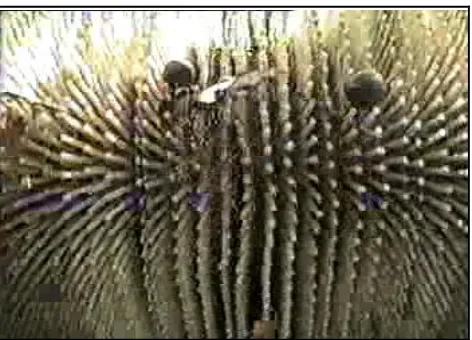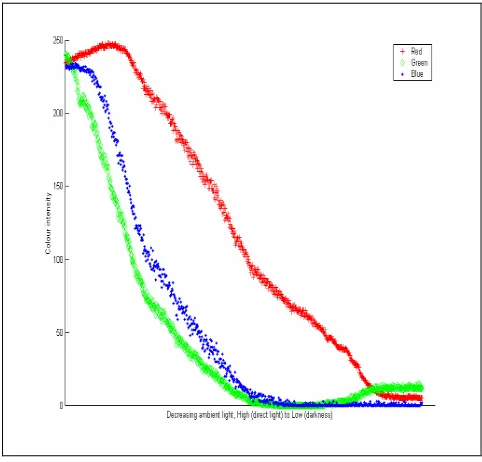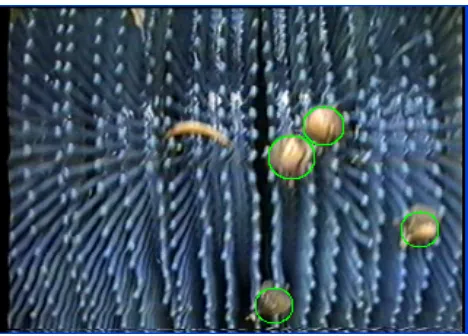Machine vision system for counting macadamia nuts
Mark DunnNational Centre for Engineering in Agriculture University of Southern Queensland
Toowoomba, Queensland 4350 Australia
Mark.dunn@usq.edu.au Prof John Billingsley
Faculty of Engineering and Surveying University of Southern Queensland
Toowoomba, Queensland 4350 Australia
Abstract
A need has been identified for more advanced technology to assist harvesting in the macadamia nut industry. An accurate automated method for counting nuts as they are harvested is required to replace manual labour in varietal strain investigation. A machine vision approach of counting the nuts in real time as they are collected has been chosen. This paper presents a machine vision system that implements fast, efficient algorithms for circle detection and object tracking. Experimental results from initial field tests show that the method is a viable option and further field trials will be undertaken.
1 Introduction
Varietal strain investigation in macadamia nut farming is a very time-consuming, labour intensive task. For each tree of each new variety, the nuts must be gathered and counted. The number of nuts produced by a specific variety of tree in a season is one of 26 different characteristics investigated for each strain. As the trees take around 5 years to reach commercial viability and it is only after this that any crosses can be made for the next generation, this work is crucial in developing better plantations.
1.1
Macadamia Nut harvesting
Macadamia nut trees are planted at intervals of 6 metres in rows 8 metres apart. When the nuts are mature, they fall from the trees to the ground below. Nuts falling in the areas between the trees not accessible by tractor are regularly blown into the open areas with a high-powered fan. The current method of mechanically collecting nuts is via a set of rollers on a harvesting wheel connected to the front of a tractor. The harvesters are generally between 1.5m and 4.0m
wide. The nuts are picked up by becoming lodged between flexible plastic fingers on the rollers, and then dislodged by combs between wheels into a series of augers which transport the nuts to a collection bin on the back of the tractor. The augers also de-husk the nuts and remove leaves and trash from the flow of produce. The first auger collects the nuts from the pickup wheels and propels the stream across the face of the harvester to a second auger which transports the nuts to the collection bin.
This means that the flow in the auger aggregated over any time interval will represent nuts gathered from a sharply angled parallelogram of ground beneath the tree. The 'dropping zone' of any specific tree cannot be tiled by such parallelograms, and so the simplistic method of monitoring auger flow is inappropriate. By observing the pickup rollers visually, an exact map is obtained of the locations from which the nuts are gathered. Although it is hoped that the growers will be content with simple rectangular aggregated counts, the way is open for more sophisticated positional analysis if necessary.
1.2
Current methods
Cultivar trials are run in Australia each year by some producers and also by scientific bodies such as CSIRO and DPI. The current method of counting the nuts from each variety is to employ labourers to rake the area beneath each tree and collect the nuts into buckets. The nuts from each area are then manually counted and a sample of these used for testing other characteristics. The count is converted into a yield figure by multiplying by the average weight found from the sample, either kernel only or nut-in-shell.
This manual method is becoming less feasible as there are more varietal strain tests taking place each year, and not enough skilled labour to cover all testing sites.
2
Proposed Machine vision System
It is proposed to implement a machine vision solution to this problem by mounting a set of cameras to the frame of the harvester to automatically count the nuts as they are collected. A preliminary machine vision solution has been simulated (Billingsley 2002) to verify feasibility. In the current study, field trials have been conducted and the analysis system has been implemented for real-time operation.
A harvesting tractor generally travels at around 8kph or 2.2m/s. The roller diameter is 0.5m, so the circumference is 1.5metres. This means that the rollers are moving at 1.4 revolutions per second. Given that a camera would capture around 60 degrees of the image per frame (figure 2), the system must process at more than 9 frames per second.
Figure 2. Camera mounting
Due to the mounting constraints, each camera can only capture a 0.5m horizontal slice of the harvester. A 4.0m wide harvester would then require 8 capture sources. There are two hardware options: mount cheap cameras on the machinery and connect directly to an on-board computer to process in real-time, or mount more expensive recording devices and process the data off-line. An experimental trial has been performed using the recording/off-line option, but it is believed that the real-time option is viable and cheaper. This method will be used in the next series of trials.
frame. The nuts travel from the bottom of the frame to the top as they are collected. Around 20 minutes of recording was taken for further off-line processing. Figure 3 shows an example frame with two nuts visible at the top of the rollers.
Figure 3. Example video frame
[image:2.612.316.552.111.281.2]The plastic fingers on the rollers are white and, after use, become smudged with dirt. As seen in figure 4, RGB values for sample nuts on a white (light brown) background are not separated enough to easily discriminate correctly in any colour channel or combination thereof.
Figure 4. Intensity contrast for nuts vs. White rollers
Figure 5. Example video frame
Figure 5 is an example frame from the video stream to be processed. The video camera setting was not set to the highest shutter speed for this test and so there is some blurring in the direction of travel. This blur does not prohibit accurate discrimination of the nuts as the exact position of the edge is not required, only the probability of any part of the frame being a macadamia nut, and a count derived from there.
[image:3.612.55.290.50.237.2]Figure 6 displays Red/Green/Blue intensity plots for sample nuts and blue background. As shown, in the left-most plot, there is a distinct separation in the Red/Blue colour channels that will allow accurate identification of non-background areas. Figure 7 illustrates that trash such as leaves and twigs picked up by the rollers cannot be separated from nuts based on colour data alone. This means that there must be some shape checking to ensure only nuts are counted.
[image:3.612.56.295.435.625.2]Figure 6. Intensity contrast for nuts on Blue background
Figure 7. Intensity contrast for trash on Blue background
Ambient Light Effects
[image:3.612.314.555.466.697.2]Figure 8. Sample nut RGB values under changing ambient light
Shape: In search of circles
A fast, efficient algorithm has been implemented to find circles within an image. Most existing algorithms use Hough transforms (Illingworth and Kittler 1988) or variants thereof to detect the presence of circles. These methods are generally slow and not suited to the task of real time processing. Davies (1997) has formulated a much faster algorithm that works on chord-bisection to find the centre of circles, however this is still a parameter space searching technique. The proposed algorithm instead finds ‘blobs’ in an image that could be circles, identifies the centre and radius using three edge points, then verifies the existence of a circle by examining boundary transitions around the proposed circle edge, similar to the algorithm for grading Broccoli heads (Billingsley and Schoenfisch 1995).
Given points
(
x
1,
y
1) (
,
x
2,
y
2) (
,
x
3,
y
3)
on the edge of an object that is possibly a circle, it can easily be demonstrated that the equations for the centre (a,b) and radius (r) of the circle are as follows.( ) ( )
[
]
( )
[
( ) ( )
]
( )
( )( ) ( )( )
[
]
( ) ( )
[
]
( )
[
( ) ( )
]
( )
( )( ) ( )( )
[
]
( )
21 2 1 1 2 1 3 1 3 1 2 1 3 2 1 2 1 2 2 2 2 1 2 2 1 2 1 2 3 2 3 1 2 1 3 1 3 1 2 1 2 2 1 2 1 2 3 2 3 1 3 2 1 2 1 2 2 2 2
)
(
4
2
2
4
2
2
b
y
a
x
r
y
y
x
x
y
y
x
x
x
x
y
x
y
x
x
x
y
x
y
x
b
y
y
x
x
y
y
x
x
y
y
y
x
y
x
y
y
y
x
y
x
a
−
+
−
=
−
−
−
−
−
−
+
−
+
−
−
+
−
+
=
−
−
−
−
−
−
+
−
+
−
−
+
−
+
=
2.2 Software
Software was written in C++ using Directshow technology from Microsoft. This technology allows fast access to the data buffers storing the RGB information for each video frame. It is reasonable to expect in excess of 25 frames per second with limited processing of each frame. This is over the requirements of 9fps given for the moving harvester mounted camera. This code can be used in both real-time mode and for processing pre-recorded images.
For each frame to be processed, the algorithm performs the following tasks:
Divide the frame into a grid at a reasonable pixel size, depending on the distance from the camera to the rollers. In
At each of the grid points, search for a non-blue value, indicating the presence of something on the rollers – either a nut, or trash.
From this identified object point, step vertically up, down and right until a boundary is reached. This gives three points on the edge of a potential circle. If any direction is more that twice the diameter of an average nut, this point should be skipped as it is probably trash.
Figure 9. Potential circle detected
After a potential circle has been identified, we need to verify whether or not a circle actually exists in this position. Given that the image is discrete and the circle boundary is not an exact line, we can check two points, at the radius plus or minus a percentage TB from the centre
for a boundary in this region. If the inner pixel meets the target value and the outer pixel does not, then there is an edge between the two.
In a digital circle, there are approximately 2*pi*r pixels on the edge and thus (2*pi*r) discrete angles to check. After checking and summing the matching angles, if the count is over a threshold percentage of the angles (TV)
then there is a circle described by (a,b,r). These circle parameters are stored to ensure that the same circle is not found more than once. No further points on the main grid in this area are checked.
[image:4.612.315.551.165.351.2]Figure 10. Virtual search space
The above image is never actually generated by the system, but only selected grid points evaluated. Figure 11 shows the end result of this processed example frame, with the identified nuts circled.
Figure 11. Example processed frame
Note that the two nuts close together have been identified correctly, and the small leaf in the image has been discounted correctly.
This software was implemented on a Pentium III 533MHz computer using C++. Five sample video clips were analysed manually and automatically to give the results in Table 1.
Sample# Duration (seconds)
Manual Count
Auto Count
Error
1 10 136 120 11%
2 12 102 91 10%
3 09 124 115 7%
4 13 51 50 2%
[image:5.612.307.542.94.181.2]5 10 73 75 3%
Table 1. Experimental results
As shown in the table above, there is still some improvement required in the algorithms. The main reason for missed nuts is occlusion or partial occlusion by trash. This causes the circle recognition algorithm to fail. There is also some double counting of nuts due to lateral movement between frames and miscounted trash.
The level of accuracy achieved is considered viable given the level of resource savings. Further in-field testing will be undertaken to verify the accuracy of the system with large runs of data (>30 minutes).
3 Conclusions
This paper has outlined a machine vision system for automatically counting macadamia nuts as they are harvested. It shows that real-time processing of live or recorded data is feasible and accurate enough for further testing to be undertaken. Blue rollers have been manufactured by the addition of blue dye to the plastic in casting at no extra cost. Full scale field tests have been scheduled for the next harvest season.
References
Billingsley, J. (2002). The Counting of Macadamia Nuts. Mechatronics and Machine Vision, Chiang Mai, Thailand, Research Studies Press Ltd.
Billingsley, J. and M. Schoenfisch (1995). Vision and Mechatronics Applications at the NCEA. Fourth IARP workshop on Robotics in Agriculture and the Food Industry, Toulouse.
Davies, E. R. (1997). Machine Vision Theory Algorithms, Practicalities. London, Academic Press.
[image:5.612.54.288.353.521.2]

